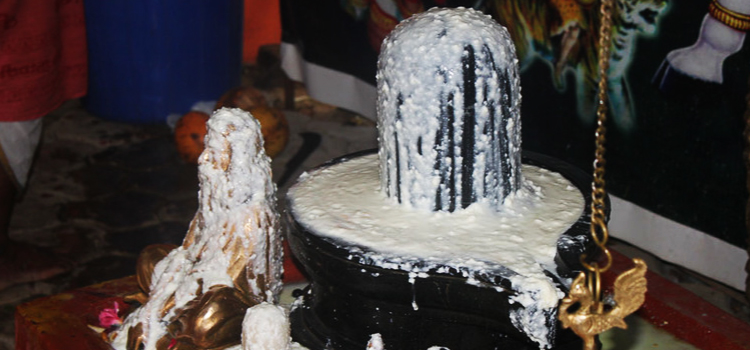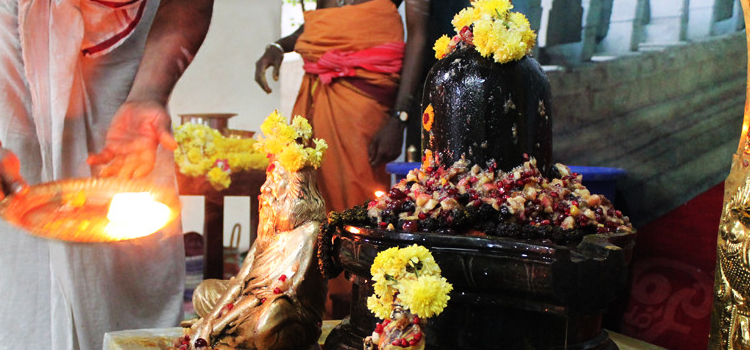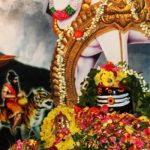Pradosham occurs when Shiva removes the bad karma of people. Pradosham means the removal of sins. People worship Shiva and his consort Parvati on this day. Pradosham falls on the 13th day of Trayodashi (lunar cycle) and occurs twice a month, once during the waxing period of the moon when Amavasya (New Moon day) occurs, and once during the waning period of the moon Pournami (Full Moon day) occurs.
The Pradosham Vrat occurs twice a month. The Pradosham days are when the negative karma or energies that curtail our potential to progress in life become redundant. Milk gives long life, and ghee gives Moksha (salvation). So, devotees make these offerings and pray to the Gods and receive abundant blessings.
The Pradosham falling on a Monday is called Soma Pradosham. The Pradosham falling on a Saturday is called Shani Pradosham. Among the PradoshamVrats(fast), people consider these two days as significant.
What is Shani Pradosham?
Shani is the God of Justice and measures the bad karma of people that gives them adverse effects. He is one of the Navagraha deities. His presence harms individuals when placed in a specific position in a horoscope. People offer prayers to Shani Dev on Saturdays, and they also believe that offering prayers to Shiva on Shani Prasdosham and observing the Shani Pradosham Vrat can help them escape from the ill-effects of Shani.
People, on Shani Trayodashi, perform remedial measures to nullify Shani’s negative effects. They pray to Shani Dev with utmost devotion, and he blesses them, giving them peace and helping them overcome the threats in life.
Shani Pradosham falls on a Saturday, and people consider this day as very significant. People offer pooja to Shiva and appease Shani Dev. Shiva is the mentor of Shani Dev, and he influences the latter to reduce the impact of people’s negative karma. People call Shiva Ashutosh as they can calm him. People observe fast on this day and read the Shani Katha.
People perform rituals during twilight as Shiva and his consort Parvati are in a favorable mood then. Shani Pradosham is the best day to observe remedies for Shani Dev.
Rituals Associated with Shani Pradosham
● Observe a Sattvic (organic) fast on Shani Pradosham, or a partial fast
● Recite the Hanuman Chalisa, the best way to appease Shani Dev
● Light a lamp with sesame oil at sunset
● Listen to Sri Rudram during the Pradosham time
● Chant Om Namah Shivaya 108 or 1008 times
● Chant a simple Shani Mantra
● Donate to the less fortunate
● Unclutter your home
● Do not purchase oil, broom, cleaning utilities, umbrella and iron items
● Feed crows
● Walk barefoot on grass
● Read chapters from the Shani Mahatmya (The Greatness of Saturn)
Legend of Shani Pradosham
A learned Brahmin and his wife Ambika lived in a place called Kurvapur. They had sons, but all of them died, barring the youngest, who was dull-headed. He was unable to learn or grasp anything, and his father died in despair. Mother and son lived in poverty and took to begging. They lived in despair. One day they went to the river to end their lives. As they approached the riverbank, the mother saw Sripada Sai Vallabha, who had come for his bath. The mother felt soothed, seeing his spiritual face and halo. Her desperation turned to peace. She prostrated in front of him, expressing her desire to have a son like him in her next birth. He agreed and advised her to maintain a Vrat worshipping Maheshwara on the Trayodashi Thithi days that coincided with the Saturdays called Shani Pradosham. He said if she observed the Vrat fervently, she would have a son equal to Lord Krishna. Sai Vallabha then narrated the following story to the mother.

The city of Ujjain, Madhya Pradesh, was called Avantika and was an important center for the spiritual aura. Students came to the city to study the holy scriptures. Ujjain’s ruler was king Chandrasen, a pious devotee of Shiva. He worshipped him all the time, and Shiva presented him with a rare celestial gem. King Singhaditya and Ripudaman of the neighboring kingdoms were avaricious and planned to attack Ujjain and take the treasure. King Chandrasen was unaware of the plot. While worshipping Shiva, the king was joined by Shrikar, a farmer’s son, who had heard him chant Shiva’s name. The guards forced the boy to the outskirts near the river Kshipra.
Shikar’s mother, angered by his delay, found him worshipping a stone he had substituted for the Lingam. She threw the stone away, and Shikar prayed to Shiva, begging to atone for her sin. Shiva, moved by the boy’s plight, appeared before him in the form of a Lingam. From this Jyotirlinga, emerged the temple of Mahakaleshwar. The brilliance of the Lingam protected the city of Ujjain.
The sage blessed Ambika’s son. The duo became enlightened by his mere touch and gained wisdom and knowledge. He became proficient in the scriptures and made his mother happy beyond measure.
Another legend has it that the hostile kings attacked Ujjain on Saturday, Trayodashi. They plundered the city of Ujjain with the help of a powerful and invisible demon, Dushan. They attacked the devotees of Shiva. God heard the pleas of his frightened and helpless devotees and appeared as Mahakal (a form of light). He destroyed the enemies of King Chandrasen and, upon the request of his devotees, agreed to be the chief deity of the kingdom. Shiva resides as Mahakal in the form of a Lingam.
Shani Pradosham Vrat Katha
Legend has it that there lived a wealthy man who had plenty of riches but no children. He and his wife decided to go on a pilgrimage and handed over the work to his subordinates. On the way, they met a monk and sought his blessings before proceeding further. Though they interrupted the monk’s meditation, he merely smiled and suggested that the couple perform the Shani Pradosham Vrat (fast) to have their wish fulfilled. The couple returned from their pilgrimage and observed the Shani Pradosham Vrat. After some time, God blessed them with a child.
Benefits of Worship on Shani Pradosham Vrat
● Worshipping Shiva frees people from disease and fear of death
● People recover lost wealth



В условиях большого города доставка еды стала неотъемлемой частью обыденности. Множество людей ценят удобство, которое она предоставляет, позволяя сэкономить время. В последние годы доставка еды — это не только способ быстро перекусить, но и важная часть в жизни busy людей. Множество сервисов предлагают разнообразие блюд, что делает этот сервис особенно актуальным для людей, ценящих комфорт и вкус. Без удобства быстрой доставки сложно представить жизнь в мегаполисе, где каждый день приносит новые задачи и вызовы.
http://4period.ru/forum/index.php?topic=39722.new#new
Our e-pharmacy provides a wide range of pharmaceuticals with competitive pricing.
Customers can discover various remedies for all health requirements.
We work hard to offer safe and effective medications while saving you money.
Quick and dependable delivery guarantees that your order gets to you quickly.
Take advantage of shopping online on our platform.
https://www.bawabetalquds.com/wall/blogs/8197/Deltasone-A-Versatile-Treatment-for-Inflammation-and-Immune-Conditions
Мы предлагаем аренду автобусов и микроавтобусов с водителем для крупных корпораций, малого и среднего бизнеса, а также частным лицам.
https://avtoaibolit-76.ru/
Обеспечиваем удобную и безопасную транспортировку для групп людей, предусматривая транспортные услуги на свадьбы, деловые мероприятия, познавательные туры и все типы мероприятий в Челябинске и Челябинской области.
Exquisite wristwatches have long been a benchmark of excellence. Crafted by renowned brands, they combine classic techniques with modern technology.
Every component demonstrate exceptional attention to detail, from intricate mechanisms to premium finishes.
Wearing a timepiece is more than a way to check the hour. It signifies timeless elegance and uncompromising quality.
Whether you prefer a classic design, Swiss watches deliver unparalleled beauty that stands the test of time.
http://bollingerforums.org/threads/watch-enthusiasts-unite.231/
Оформление сертификатов в России по-прежнему считается неотъемлемым процессом выхода продукции на рынок.
Этот процесс подтверждает полное соответствие нормам и законам, что, в свою очередь, гарантирует защиту конечных пользователей от небезопасной продукции.
сертификация качества продукции
К тому же, официальное подтверждение качества облегчает взаимодействие с крупными ритейлерами и открывает конкурентные преимущества на рынке.
Если продукция не сертифицирована, не исключены штрафы и барьеры при продаже товаров.
Таким образом, официальное подтверждение качества является не просто обязательным, а также залогом устойчивого роста бизнеса в сфере торговли.
Даркнет — это анонимная зона онлайн-пространства, куда можно попасть исключительно через защищенные браузеры, такие как Tor.
В этой среде можно найти легальные , включая форумы и другие площадки.
Одной из таких онлайн-площадок является BlackSprut, которая предлагала продаже разнообразной продукции.
https://bs2best
Такие ресурсы нередко используют анонимные платежи для обеспечения скрытности сделок.
Что такое BlackSprut?
Платформа BlackSprut удостаивается обсуждения широкой аудитории. Что делает его уникальным?
Эта площадка предлагает интересные функции для тех, кто им интересуется. Визуальная составляющая сайта отличается удобством, что делает платформу интуитивно удобной даже для тех, кто впервые сталкивается с подобными сервисами.
Стоит учитывать, что BlackSprut имеет свои особенности, которые отличают его в своей нише.
Обсуждая BlackSprut, нельзя не упомянуть, что различные сообщества выражают неоднозначные взгляды. Некоторые отмечают его удобство, а кто-то оценивают его с осторожностью.
Подводя итоги, BlackSprut остается темой дискуссий и вызывает заинтересованность широкой аудитории.
Рабочее зеркало к БлэкСпрут – проверьте у нас
Если нужен актуальный домен БлэкСпрут, то вы по адресу.
bs2best at сайт
Сайт часто обновляет адреса, поэтому важно знать обновленный домен.
Мы следим за актуальными доменами чтобы предоставить новым зеркалом.
Проверьте рабочую версию сайта прямо сейчас!
Здесь представлены последние международные политические новости. Регулярные обновления позволяют следить за важных событий. Вы узнаете о глобальных политических процессах. Подробные обзоры помогают разобраться в деталях. Оставайтесь информированными на этом сайте.
https://justdoitnow03042025.com
Taking one’s own life is a complex topic that touches millions of people across the world.
It is often associated with emotional pain, such as anxiety, hopelessness, or chemical dependency.
People who struggle with suicide may feel overwhelmed and believe there’s no other way out.
How to kill yourself painless
We must spread knowledge about this subject and offer a helping hand.
Prevention can reduce the risk, and finding help is a necessary first step.
If you or someone you know is in crisis, get in touch with professionals.
You are not without options, and support exists.
На нашем портале вам предоставляется возможность наслаждаться большим выбором игровых автоматов.
Эти слоты славятся яркой графикой и интерактивным игровым процессом.
Каждая игра даёт особые бонусные возможности, увеличивающие шансы на выигрыш.
1xbet игровые автоматы
Игра в игровые автоматы предназначена как новичков, так и опытных игроков.
Можно опробовать игру без ставки, и потом испытать азарт игры на реальные ставки.
Испытайте удачу и насладитесь неповторимой атмосферой игровых автоматов.
This portal provides access to a wide selection of online slots, ideal for both beginners and experienced users.
Here, you can explore classic slots, feature-rich games, and progressive jackpots with amazing animations and realistic audio.
Whether you’re looking for easy fun or love complex features, you’re sure to find something that suits you.
http://electronika.spb.ru/%D0%B2-instagram-%D0%B2%D1%8B%D1%81%D0%BC%D0%B5%D1%8F%D0%BB%D0%B8-apple-airpods-%D0%BF%D0%B5%D1%80%D0%B5%D0%B4-%D0%BF%D1%80%D0%B5%D0%B7%D0%B5%D0%BD%D1%82%D0%B0%D1%86%D0%B8%D0%B5%D0%B9-%D1%81%D0%BF-21268/
All games can be accessed 24/7, right in your browser, and well adapted for both PC and mobile.
Besides slots, the site features helpful reviews, welcome packages, and player feedback to enhance your experience.
Join now, start playing, and enjoy the world of digital reels!
Здесь вам открывается шанс испытать широким ассортиментом игровых слотов.
Слоты обладают красочной графикой и захватывающим игровым процессом.
Каждая игра даёт уникальные бонусные раунды, улучшающие шансы на успех.
1win games
Игра в игровые автоматы предназначена игроков всех уровней.
Можно опробовать игру без ставки, после чего начать играть на реальные деньги.
Испытайте удачу и насладитесь неповторимой атмосферой игровых автоматов.
Этот портал дает возможность поиска работы в разных регионах.
Пользователям доступны актуальные предложения от проверенных работодателей.
Сервис собирает варианты занятости по разным направлениям.
Частичная занятость — вы выбираете.
Работа для киллера Украина
Поиск удобен и подстроен на новичков и специалистов.
Создание профиля займёт минимум времени.
Готовы к новым возможностям? — сайт к вашим услугам.
Our service makes it possible to connect with workers for temporary dangerous missions.
Clients may securely request services for unique situations.
All contractors are experienced in handling complex activities.
killer for hire
Our platform offers safe arrangements between requesters and workers.
For those needing fast support, the site is the right choice.
Post your request and get matched with a skilled worker now!
Il nostro servizio offre la selezione di persone per attività a rischio.
Chi cerca aiuto possono scegliere professionisti specializzati per operazioni isolate.
Gli operatori proposti sono valutati secondo criteri di sicurezza.
sonsofanarchy-italia.com
Attraverso il portale è possibile leggere recensioni prima della selezione.
La fiducia continua a essere la nostra priorità.
Contattateci oggi stesso per portare a termine il vostro progetto!
This website, you can access lots of casino slots from famous studios.
Visitors can try out traditional machines as well as feature-packed games with vivid animation and interactive gameplay.
Even if you’re new or a seasoned gamer, there’s always a slot to match your mood.
play casino
The games are instantly accessible round the clock and compatible with PCs and mobile devices alike.
All games run in your browser, so you can get started without hassle.
The interface is intuitive, making it simple to explore new games.
Register now, and dive into the world of online slots!
Looking for someone to take on a single risky assignment?
This platform focuses on connecting clients with workers who are willing to perform critical jobs.
Whether you’re dealing with emergency repairs, unsafe cleanups, or complex installations, you’re at the perfect place.
All available professional is vetted and qualified to guarantee your safety.
hire a killer
This service provide transparent pricing, detailed profiles, and secure payment methods.
Regardless of how challenging the scenario, our network has the skills to get it done.
Begin your quest today and find the ideal candidate for your needs.
Searching for someone to take on a rare risky task?
Our platform focuses on linking customers with workers who are ready to perform high-stakes jobs.
If you’re dealing with emergency repairs, unsafe cleanups, or complex installations, you’ve come to the perfect place.
Every available professional is pre-screened and certified to ensure your safety.
hire a hitman
This service offer transparent pricing, detailed profiles, and secure payment methods.
Regardless of how difficult the scenario, our network has the skills to get it done.
Start your quest today and locate the perfect candidate for your needs.
Welcome to our platform, where you can access exclusive materials designed exclusively for grown-ups.
The entire collection available here is intended for individuals who are over 18.
Please confirm that you are eligible before continuing.
teen videos
Experience a one-of-a-kind selection of adult-only materials, and immerse yourself today!
This resource you can obtain special voucher codes for a top-rated betting company.
The range of discount deals is frequently refreshed to assure that you always have reach to the modern offers.
Through these promotional deals, you can cut costs on your betting actions and enhance your possibilities of triumph.
Every coupon are accurately validated for reliability and working condition before appearing on the site.
https://pacificacontinental.com/wp-content/pgs/skolyko_stoit_otkryty_magazin.html
Plus, we provide comprehensive guidelines on how to put into action each rewarding chance to improve your bonuses.
Keep in mind that some deals may have definite prerequisites or time limitations, so it’s essential to study closely all the facts before activating them.
Our platform features many types of prescription drugs for home delivery.
You can easily buy essential medicines from your device.
Our range includes standard drugs and targeted therapies.
The full range is supplied through trusted distributors.
is fildena safe
We maintain quality and care, with data protection and timely service.
Whether you’re managing a chronic condition, you’ll find safe products here.
Begin shopping today and enjoy trusted access to medicine.
Our platform offers a large selection of pharmaceuticals for ordering online.
You can quickly buy treatments without leaving home.
Our range includes standard treatments and targeted therapies.
All products is provided by verified suppliers.
cenforce 100mg price in india
We prioritize user protection, with private checkout and prompt delivery.
Whether you’re managing a chronic condition, you’ll find safe products here.
Explore our selection today and get reliable healthcare delivery.
Can you be more specific about the content of your article? After reading it, I still have some doubts. Hope you can help me.
The Aviator Game merges exploration with exciting rewards.
Jump into the cockpit and try your luck through aerial challenges for massive payouts.
With its classic-inspired graphics, the game reflects the spirit of aircraft legends.
aviator game download link
Watch as the plane takes off – claim before it flies away to secure your winnings.
Featuring instant gameplay and immersive sound effects, it’s a favorite for slot enthusiasts.
Whether you’re looking for fun, Aviator delivers endless excitement with every round.
这个网站 提供 海量的 成人内容,满足 成年访客 的 喜好。
无论您喜欢 哪种类型 的 影片,这里都 一应俱全。
所有 材料 都经过 严格审核,确保 高清晰 的 视觉享受。
黄色书刊
我们支持 多种设备 访问,包括 手机,随时随地 自由浏览。
加入我们,探索 激情时刻 的 两性空间。
On this platform, you can find a great variety of casino slots from top providers.
Visitors can enjoy classic slots as well as new-generation slots with high-quality visuals and interactive gameplay.
If you’re just starting out or a seasoned gamer, there’s a game that fits your style.
play aviator
All slot machines are instantly accessible round the clock and optimized for PCs and mobile devices alike.
You don’t need to install anything, so you can get started without hassle.
Platform layout is easy to use, making it convenient to find your favorite slot.
Register now, and discover the world of online slots!
Здесь вы найдете фото и видео для взрослых.
Контент подходит тем, кто старше 18.
У нас собраны широкий выбор контента.
Платформа предлагает качественный контент.
порно онлайн с русским переводом
Вход разрешен исключительно 18+.
Наслаждайтесь удобным интерфейсом.
The AP Royal Oak 15400ST is a stainless steel timepiece launched as a modern classic within the brand’s prestigious lineup.
The watch’s 41mm steel case boasts an octagonal bezel highlighted by eight bold screws, a hallmark of the Royal Oak’s bold aesthetic.
Powered by the automatic Cal. 3120 movement, guarantees seamless functionality with a date display at 3 o’clock.
Audemars Piguet 15400 st
A sleek silver index dial with Grande Tapisserie highlighted by luminous appliqués for clear visibility.
The stainless steel bracelet offers a secure, ergonomic fit, fastened via a signature deployant buckle.
Renowned for its iconic design, it continues to captivate collectors for those seeking understated prestige.
Thank you for your sharing. I am worried that I lack creative ideas. It is your article that makes me full of hope. Thank you. But, I have a question, can you help me?
Eng yaxshi online kazino — bu pussybet casino!
?? Slotlar, breathe kazino, bonuslar!
?? O‘zbek tilida ishlaydi, pul chiqarish muammo emas!
?? Bugun omad siz bilan bo‘lsin!
Eng yaxshi online kazino — bu casino uz!
?? Slotlar, live kazino, bonuslar!
?? O‘zbek tilida ishlaydi, pul chiqarish muammo emas!
?? Ro‘yxatdan o‘ting hoziroq!
Нужно собрать информацию о человеке ? Наш сервис предоставит детальный отчет в режиме реального времени .
Воспользуйтесь уникальные алгоритмы для поиска публичных записей в открытых источниках.
Выясните место работы или активность через автоматизированный скан с гарантией точности .
новый глаз бога
Бот работает с соблюдением GDPR, используя только общедоступную информацию.
Получите детализированную выжимку с геолокационными метками и графиками активности .
Попробуйте надежному помощнику для digital-расследований — точность гарантирована!